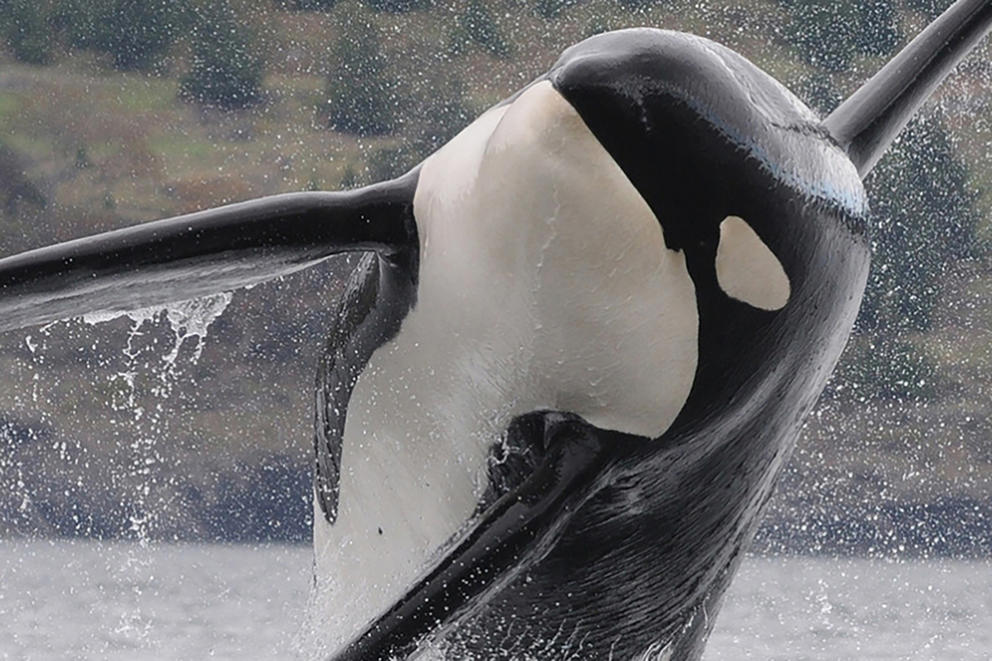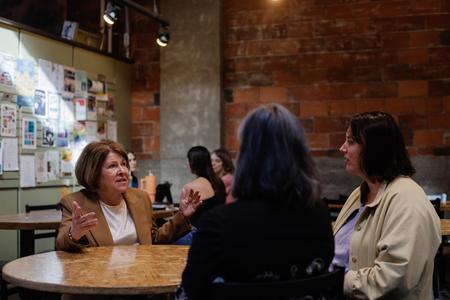Podcast | Protecting orcas and their songs from noxious noise
Oceanographer Scott Veirs shows us how to listen for whales in Puget Sound, identify their signature sounds and maybe help save them.

The endangered southern resident killer whale. (NOAA Fisheries/National Marine Fisheries Service)
If Puget Sound has an animal celebrity, it’s the orca — specifically, the southern resident population of killer whales. About 70 individuals divided into three family groups, or pods, make their home in our waters for large parts of the year. Fans from all over the world follow every movement of the southern residents; they mourn every whale death; they rejoice when a new calf joins a pod.
These camper-van-sized whales subsist almost entirely on salmon, which they hunt in the murky sea, using only sound. But the clicks, whistles and honks they employ while hunting are also the building blocks of a rich language we’re only beginning to decode. Some elements are understood by whales all over the world, but each pod has its own unique dialect used only among family members.
In this episode of Crosscut Escapes, oceanographer Scott Veirs tells us about his Orcasound project, which allows anyone with an internet connection to listen for whales and even learn to identify the signature sounds of our cetacean superstars. As we listen, we’re learning more about how orcas behave when we can’t see them — and how we might save them from the human-caused noises that intrude on their watery world.
Subscribe to Crosscut Escapes on Apple Podcasts, Stitcher, Podbean or Overcast.
Complete transcript:
Anonymous speaker: [00:00:00] This episode of Crosscut Escapes is presented by Forterra. Land for good.
Scott Veirs: [00:00:05] If you're trying to find salmon to eat that might be swimming a hundred meters below you, like a whole football field down underwater, you can't see them, and so the only way to find them is with sound.
Ted Alvarez: [00:00:34] Welcome to Crosscut Escapes. I'm your host, Ted Alvarez, and I want to show you something.
On the shores of Puget Sound, the soundtrack is mostly peaceful. There's the lapping of gentle waves, the sighing of the breeze, maybe the odd seagull cry or a boat horn rippling across the sea. But underwater is a very different story.
Down here, it's a cacophonous symphony of noise coming from all directions. Some of it comes from wildlife, like whales or porpoises.
Some of it comes from natural processes, like bubbles or even lightning.
Plenty of it comes from us: ferries, speed boats, even the sounds of pile driving from construction back on shore. In fact, the density of water means these sounds travel more than four times faster and maintain intensity for longer. With visibility in Puget Sound rarely reaching more than 30 feet in the daytime, in ideal conditions, this dark world is almost entirely defined by sound.
And in the ocean, sound has one undisputed master.
Scott Veirs: [00:02:05] Killer whales. They are keystone predators in most marine ecosystems, and part of the reason they're so good at hunting and being at the very top of the food chain is that they use sound and sound is much more useful than light when you're you're hunting underwater.
Ted Alvarez: [00:02:22] This is Scott Veirs. He's been listening to killer whales for years.
Scott Veirs: [00:02:27] I'm an oceanographer who's turned into a marine biologists because killer whales make such cool sounds underwater, the coordinator of something called the Orca Sound Hydrophone Network, which puts underwater microphones in the habitat of killer whales so that we can all listen to them when they come into our region and also listen to what their underwater environment sounds like.
Ted Alvarez: [00:02:47] Most of us in Washington are familiar with our Southern Resident killer whales, 73 or so orcas that live in the Salish Sea between here and Southern British Columbia. They're probably the biggest wildlife celebrities we have. And they're closely watched by locals and people around the world. We hang on to their, every move, every death, every newborn that shifts their chances of survival one way or the other.
But while other killer whales might eat a variety of foods, seals, many species of fish, even sharks or other whales, our Southern residents are defined by their dependence on one very specific kind of food, Chinook salmon. It's the largest and fattiest salmon species and the most endangered. We'll get to that in a little bit, but first it's worth appreciating just how these 20 foot long, 8,000 pound hunters catch they're much tinier prey.
If you're trying to find salmon to eat that might be swimming 100 meters below your, like a whole football field down the underwater, you can't see them. And so, the only way to find them is with sound. And so not only do they coordinate their hunt by vocalizing to each other or whistling, but they do this incredible thing that other tooth whales do. they make a sound inside their head -- it comes out of their forehead as a beam, like a flashlight -- and then they listen very carefully for the faint echoes of that echo location pulse or click off of a fish. And the thing that's causing the reflection inside the fish is a tiny little swim bladder; it's a little air pocket that might be the size of a softball if it's a big Chinook salmon.
And so they can hear their sound, their click bounce off of that fish, a hundred meters away, even though the object is only the size of a softball. It's incredible.
But orcas do much more with their calls than just hunt. As scientists like Scott listen more and more to them, we're realizing orcas in general have a rich language all their own.
It's so advanced that the three individuals pods within the Southern Resident killer whale population, nicknamed J K and L pods, each have their own signature sounds they use to recognize each other. Those sounds in turn are distinct from transient killer whales who come in from the open ocean to hunt the sea mammals in our region.
Scott Veirs: [00:04:52] They have a dialect, it's analogous to a dialect and in the human language. BAsically there's about 25 different sounds that Southern Residents make that we hear as distinct calls. It makes them unique from other types of killer whales around the globe and in the region. So the calls that the Southern Resident fish-eating killer whales make is totally distinct from the calls that Northern Resident fish-eating killer whales make. And it's also different from those sounds made by killer whales that come to eat marine mammals around Seattle and Puget Sound. So, just by listening to the calls they're making, you can tell which type of killer whale they are and even which pod, based on the family groups within this type of killer whale, have their own favorite calls that the other ones don't use very much. If you learn to recognize those three calls, you can infer which pod you're hearing. J pod has this sort of honking sound. It goes up and down a little bit. And S 19 is an upward whistle. That's made more commonly by L pod and the K pod's interesting; almost everybody who hears that says, "Oh, that sounds like a kitten."
So, it's nice that they're slightly different from each other. Most people, even elementary school kids, can learn to recognize those three as distinct.
Ted Alvarez: [00:06:12] The sheer range of sounds orcas can make is incredible. And while we can't decipher exactly what it all means just yet, sometimes it sounds like they're talking to us in our language.
[whale sound]
That sounds like, "Oh, well, darn" to me.
[whale sound]
Figaro!
Between all the individual dialects, some orca sounds are universal, or at least they would be recognizable to orcas everywhere, from Antarctica to Alaska.
Scott Veirs: [00:06:38] There was a study where they listened to calls from all types of killer whales, all around the planet. And they noticed that one call, no matter geographically where the killer whales were living or what they were specializing in, sounded similar. I call it the squeaky balloon.
That's not in the literature as an excitement call. And it turned out that all around the planet, that's a common call. And so, if we're looking for an analogy in human localization, it might be laughter. You know, no matter what human culture you're listening to, the laughter sounds similar. So when we hear that, we often associate it with being excited, something exciting happening.
Other than that, that excitement call, we have no idea what any of these calls means. And we're just getting to the point where artificial intelligence and modern computational tools are helping us see these patterns. I expect we'll see more patterns. But part of the problem is that when you're listening to a single microphone underwater, it's like listening with one ear in a crowded cafe, you can't really figure out who's saying what.
These whales are making most of their calls underwater 90% of the time. They're not visible to us, so we don't know where they are, relative to each other, as we're listening. So it's very difficult to tease apart the context, the behavior, when you hear a particular sound. So, someday we may be able to have underwater cameras, multiple hydrophones that led us to say, "Oh, that was, that call was made by the calf. And then this call was made by its mother." And then we may be able to get the spatial and behavioral context to tease apart what each of those signals means.
Ted Alvarez: [00:08:14] We'll be back with more about what all those sounds from the deep might mean after a few words from our sponsor.
Anonymous speaker: [00:08:21] It takes work to sustain a place for all of us. For over 30 years, Forterra has been doing that work, taking action to promote resilient communities and healthy ecosystems across our region.
From planting thousands of trees each year, to developing attainable housing, to helping conserve over 250,000 acres of land, the Washington-based land trust has built programs and partnerships to advance conservation restoration and community resiliency across the state. For more information, go to forterra.org.
Okay. Back to the show.
Ted Alvarez: [00:09:00] Though we may not yet understand precisely what killer whales are saying, you can tune into one of Orca Sounds' hydrophones, which are streaming twenty-four, seven at orcasound.net. If you do it enough, you'll probably learn to identify which orthopod is passing by, but more often than not, you'll hear us in our many noisy forms.
This is bad news for our Southern Resident orcas who are chasing after dwindling supplies of salmon in their dark world and finding it harder and harder to do so with all the ruckus humans make.
Scott Veirs: [00:09:35] If you raise the noise levels around a killer whale that's trying to forage or hunt, you make it more difficult for them to hear the faint echoes of their echolocation clicks off of a salmon.
And so our modeling suggests that when killer whales are trying to echolocate in the presence of ship noise, they're losing something like 90% of their foraging efficiency. So, basically, it's like you're looking for food out in the forest at night with the flashlight and somebody has made it really smoky around you, so your flashlight beam doesn't go nearly as far into the forest. It's kind of like one foot instead of a hundred feet, or 10 feet instead of a hundred feet. So that's the level of impact, is 90% of their opportunities to find fish are taken away for that half an hour or 45 minutes of the ship is going by.
Location is the main way they find the fish, but then there's coordinating the hunt, like deciding who's going to do the deep dive and go down a football field underwater to find this thing in the darkness. And then there's the well-documented that they share food, just like we do within our family groups.
And so being able to communicate that you have caught a fish and that you're bringing it to the surface and everybody in your family group should come over to get a piece of it. That's also part of the efficient foraging strategy that they're using.
Ted Alvarez: [00:10:53] Here's the part where we're supposed to beat you over the head with the sad news that our salmon are in steep decline, and the fate of Southern resident orcas is in large part tied to our ability to rescue those populations. All of which is true and a very tall order. It can involve everything from expanded hatchery operations to dam removals. It could take decades and it's not clear the orcas have that much time. But I'm not going to focus on that, because when it comes to noise pollution, we can do something about that right now. And we are.
Scott Veirs: [00:11:21] The good news about noise pollution in the orca's habitat is that unlike many types of chemical pollution, as soon as you quiet the source, the pollution goes away. Thanks to the Southern Resident killer whale task force that Governor Inslee initiated, a bunch of recommendations came out end of 2018, something like 35 recommendations for how to improve the plight of the Southern Residents, and many of them had to do with noise. There were recommendations to reduce vessel disturbance that's manifest, so that can be boats or ships. On the ship side there's a recommendation to quiet ferries, Washington state ferries, and that obviously is something that Governor Inslee can get a lot of traction on. So I'm excited that we're starting to retrofit ferries with electric motors instead of in-line diesel engines, and that has the potential to reduce some of the low frequency noise that we're talking about.
The Navy is the biggest employer here in Washington state, and they are experts in how to quiet ships. So, we have all the resources we need and probably a bunch of economic opportunity to quiet commercial ships of all types, whether they're container ships or oil tankers, bulk carriers are the most common types of ships in our waters.
Ted Alvarez: [00:12:32] But it's not just commercial ships that pose a risk to orcas. Recreational motorboats have an equivalent impact when they go too fast, too close to whales.
Scott Veirs: [00:12:42] We're in the process of integrating those visual and acoustic detections into a system that can inform all kinds of mitigation for killer whales, whether it's helping Washington Department of Fish and Wildlife get out on the water to enforce those speed limits, or helping the Canadians slow down the commercial vessels, all of that is stuff that can be supported by you listening for whales and letting us know when you hear them.
Ted Alvarez: [00:13:06] In fact, you can help orcas by just putting your ear to the water and listening for them or joining one of the many citing networks that exist. Scott points out that we all have a part to play to actively nudge them into a better future.
Trying to decode their clicks and whistles might help us make better decisions on land. In the meantime, here's hoping humans can learn how to shut up a little more at sea so that killer whales can reclaim their rightful place as masters of sound.
Scott Veirs: [00:13:32] As you're listening to them, you have this privilege of listening to this wonderful natural phenomenon, or as you're on a bluff, watching the whales go by, I'm trying to make it easier for you to take action, to help them with the other non-acoustic impacts.
Mostly we need to all focus on how to get more salmon into their mouth. So helping Chinook salmon, their favorite kind of fish, recover in all of Washington's rivers, as well as in Canada, Alaska, Washington and California, that's the full range over which they seek salmon. And so I'm hoping that all these apps and technologies can bring us together so that we can solve these issues that go well beyond Washington state.
It's an exciting time to, to listen for whales.
Ted Alvarez: [00:14:10] That's it for this week's episode, many thanks to Scott Veirs and Orca Sound, who contributed the sound recordings used in this episode. You can learn more and listen for whales live at orcasound.net.
This episode was engineered by Karalyn Smith. Music and additional recording by the Explorist. You can subscribe to Crosscut Escapes on Apple Podcasts, Stitcher, or wherever you listen.
For more on Crosscut Escapes, go to crosscut.com/escapes.
And if you liked the show, please review us. It helps other people find us.
Crossroad Escapes is a product of Cascade Public Media.
I'm Ted Alvarez, and we'll be back with another episode next week.



